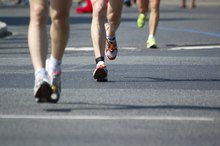What does fact checked mean?
At Healthfully, we strive to deliver objective content that is accurate and up-to-date. Our team periodically reviews articles in order to ensure content quality. The sources cited below consist of evidence from peer-reviewed journals, prominent medical organizations, academic associations, and government data.
The information contained on this site is for informational purposes only, and should not be used as a substitute for the advice of a professional health care provider. Please check with the appropriate physician regarding health questions and concerns. Although we strive to deliver accurate and up-to-date information, no guarantee to that effect is made.
Definition of Physical Stamina
Physical stamina is one of several components used to evaluate health and fitness 2. It includes cardiovascular and muscular endurance, which is the ability of your heart, lungs and muscles to work for long periods without pooping out. Muscular and cardiovascular stamina levels can be increased through physical activity, which leads to improved overall health.
Types of Stamina
Physical stamina can refer to the ability of your heart and lungs to function during high-intensity activities. Your heart and lungs supply increased amounts of blood and oxygen to meet the demands of prolonged physical activity. This can also be referred to as cardiovascular endurance. Going for a long walk or completing a running or cycling race require cardiovascular endurance.
Muscular enduranace is your body's ability to complete repetetive movements against resistance for sustained periods of time. This could be anything from climbing the stair stepper at the gym to raking leaves in your yard. Muscular endurance relies on cardiovascular endurance, because it is your heart that pumps fresh blood and oxygen to meet the demands of hard-working muscles.
- Physical stamina can refer to the ability of your heart and lungs to function during high-intensity activities.
Benefits of Physical Stamina
How to Tighten Up the Thighs and Calves
Learn More
Physical stamina is crucial to your health and quality of life. Obvious benefits include being able to carry out tasks of everyday life with ease. You have increased energy, and you won't tire out climbing stairs, taking a walk with friends or playing with your kids.
Physiological benefits of increased stamina include decreased resting heart rate and lower blood pressure 2. With physical stamina it's also easier to be more active and control your weight, which can prevent weight-related diseases like diabetes, cancer and heart disease.
Physical stamina also has psychological benefits 23. Since exercise is a proven stress reliever, the ability to stay active can make you feel calmer. The endorphins released through exercise can also decrease anxiety and depression. In addition, physical stamina can affect mental stamina and fortitude; being able to complete a physically intense activity can give you confidence to tackle whatever life throws your way.
- Physical stamina is crucial to your health and quality of life.
- Since exercise is a proven stress reliever, the ability to stay active can make you feel calmer.
Improving Stamina
Training to improve physical stamina involves cardio and strength-training activities. Activities such as walking, jogging, elliptical training and group aerobics classes are examples of cardio training. These activities raise your heart rate and strengthen your heart and lungs. Perform these activities for at least 20 minutes at a moderate pace most days of the week.
You can further increase cardiovascular endurance by extending your workouts and mixing in some more intense activities. Longer workouts and greater intensity challenge the heart and lungs to continue to get stronger. Try doing a few longer cardio workouts of at least 30 minutes at a moderate pace a few times a week.
Interval training is one method of increasing intensity. To do it, alternate periods of all out effort, such as sprinting, with periods of recovery at a slower pace. Because of their intensity, these workouts should be kept to 30 minutes or less.
Resistance training improves muscular endurance. Lift weights or do body weight calisthenics to target all the major muscle groups in your body -- arms, shoulders, chest, back, abs and legs. Use lighter weights and do higher repetitions -- 12 to 20 -- each set to increase stamina. Do resistance training at least two days per week.
- Training to improve physical stamina involves cardio and strength-training activities.
- Lift weights or do body weight calisthenics to target all the major muscle groups in your body -- arms, shoulders, chest, back, abs and legs.
Other Considerations
How Many Calories Are Burned on an Elliptical Machine?
Learn More
Your diet and lifestyle play an important role in stamina. Eating a healthy diet rich in nutrients will give you more energy to stay active. Focus your diet around fresh fruits and vegetables, whole grains, lean meats and healthy fats from nuts, seeds, avocado and vegetable oils. Avoid processed, fatty foods high in salt, as well as sweets and sugary beverages.
Not getting enough sleep can lead to a host of ill effects, decreased stamina among them. Be sure to get seven to nine hours of uninterrupted sleep each night.
- Your diet and lifestyle play an important role in stamina.
- Focus your diet around fresh fruits and vegetables, whole grains, lean meats and healthy fats from nuts, seeds, avocado and vegetable oils.
Related Articles
References
Writer Bio
Luann Voza teaches both math and science in an elementary school setting and physical education in a college setting. A former fitness-club owner, Voza has taught group fitness classes in step, aerobics, yoga, Pilates and kickboxing. As a bodybuilder, she held the title of Ms. New Jersey Lightweight Division Winner. Voza has a master's degree in exercise physiology and a doctoral degree in education.








